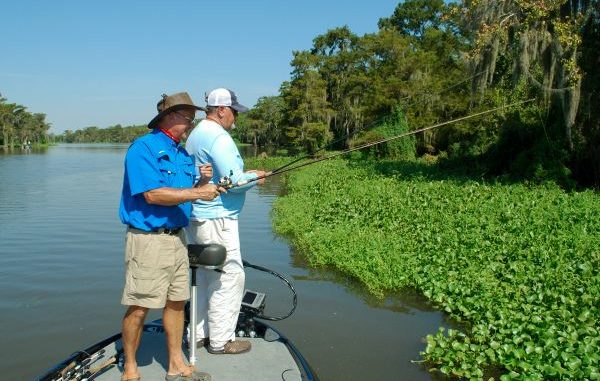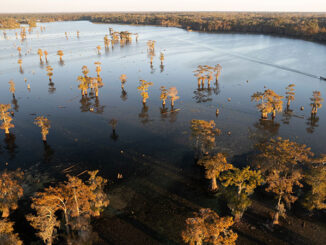
Largemouth bass fishing is cyclic. Water temperatures, and with them oxygen levels, vary by season.
Where bass are in their spawning cycle also strongly influences fishing success.
The Atchafalaya Basin has all these factors and one more — wildly fluctuating water levels. Where dry land is one season will be overwhelmed with 8 feet of muddy, flowing water or suffocated with stagnant black water in another season.
However, Atchafalaya Basin bass specialists have learned that, with some variations, bass fishing does follow a relatively predictable rhythm.
Gonzales anglers Gene Hoover and Kevin Diez share their understanding of the annual cycle in the lower Basin stretching from Bayou Pigeon to Morgan City.
First, though, comes an understanding of what desirable water color offers the best Basin fishing. Hoover and Diez agreed that, from May to December, bass anglers should look for what they call “Spillway-colored” water.
Diez described it well as “green with a little silt in it.” The slight murkiness of Spillway-colored water would not impress bass fishermen in other areas, but finding it in the Basin is important.
Hoover added that lures should be visible about 1 foot beneath the surface.
During the colder months — January through March — Basin bass fishermen should look for clear green water, the color of water so desirable to bass addicts elsewhere.
April is a toss-up month.
The two experts chose to begin their fishing calendar in November, when dense growths of vegetation have died and opened fishing opportunities in canals.
The Atchafalaya River is low at that point, typically at 2.5 feet at the Morgan City gauge, and most water movement is controlled by tides.
The vegetation die-back opens the canals to flushing action. Shad move into dead-end canals and bass follow them there.
Concentrate bass fishing in dead-end canals through April, they recommended, because that is where bass spawn.
Some of these canals will stay clear even when the river gets to 8 feet (flood stage at Morgan City is 4 feet).
Hoover recommended using shad-type baits: spinners, crankbaits and flukes.
Diez goes for shad-colored jig-and-pigs and, on warm days, topwaters.
During many years, the river stays relatively low until February. Hoover works Smithwick Rogues on pre-spawning fish in January and February.
When a cold front socks the area and the bite really slows down, he shifts to a black or blue jig with a Zoom Super Chunk trailer.
During April and May, when the river is high, Hoover recommended shifting to lakes the river has not affected as much as it has other waters. These include Cow Island, Willow Cove, American, Flat lakes.
“You are looking for any water that isn’t chocolate-colored,” he explained.
You need to fish the edges of change, where one water color gives way to another, Diez added.
“A lot of people fish the same place that they caught fish yesterday and they don’t get bit,” he said. “It’s because the water has moved and the fish have moved with it.”
Finding the sweet spot during one particular month can be tough.
“April is the worst month to find good water,” Hoover said. “Very few people fish the Basin then. There are fish to be caught, but you have to really look for them.”
The worst month is followed by the best period — the month or months when river levels fall from their flood peak.
“The drop” takes place in late May through late June in most years. Bass from flooded timber move into open canals and bayous, and feed actively.
“Once the river falls below 4 feet, the lake stuff is off,” Hoover said. “You will be looking for current flow and mixing water. (Bass) like it where clear water is mixing with stained water.”
Locating those areas where the two waters meet can’t be emphasized enough.
“The biggest thing we find is that at every level the flow rate is different, and you have to find those spots where clear water is mixing with spillway color water,” Diez said.
But it’s equally important to steer clear of oxygen-deprived water.
“Clear water has 3-foot visibility,” Diez said. “Not black water; it lacks oxygen. You won’t see any baitfish in black water.
“Spinners, crankbaits and other moving baits are most effective.”
Things change in the summer.
“Look for moving water, then,” Hoover coached. “The bass will be under vegetation — mostly (water hyacinths) in 2 or 3 feet of water near deep water. Deep water in the Spillway is 6 or 7 feet deep.”
But not all hyacinths are created equal.
“Look for hyacinths hung up on points or on laydowns,” Diez suggested.
Under these conditions, fishing involves punching heavily weighted plastics through the vegetation with short underhanded casts. The lure is bounced once or twice before being moved to another spot.
Favored lures for punching are Texas-rigged Sweet Beavers, D-Bombs and Speed Craws, all pegged between a 1- or 1 3/8-ounce bullet weight and a worm hook. Dark colors like black or blue are best.
“If there is one there, he will hit it,” Hoover said.
Diez said the strike normally comes as the lure breaks through the surface vegetation.
“Normally they hit it right away on the fall,” he said.
But he also said to keep your eyes open for other opportunities.
“(D)on’t ignore the middle of canals,” Diez said. “If you see schools of shad moving there, throw crankbaits or Rat-L-Traps in shad colors like ghost shad, blue-and-chrome or black-and-chrome at them.”
“On a cloudy, rainy day, black buzz baits will work too,” Hoover interjected.
By late summer — August going into September — Hoover turns to Brush Hogs and 6-inch Zoom Trick Worms.
The worms are rigged wacky-style, on a shaky head or Texas style. He favors June bug color or, in clear water, watermelon red.
Diez made a face at the mention of worms.
“I really don’t like worms,” he said. “While he is throwing worms, I’m usually using jigs. The size of the fish is a little bit better on jigs than worms.”
During the fall, (September to November) the cycle begins to complete itself, with shad starting to move from main bayous into dead-end canals.
“If you pull in a dead-end and see shad, you know you are going to catch fish,” Hoover said with a grin. “It’s just a matter of finding what they want.”
Top lures are spinnerbaits, Rat-L-Traps and Zara Spooks.
